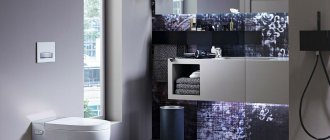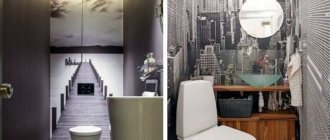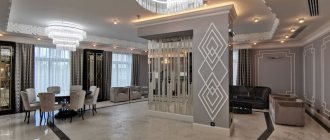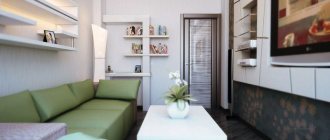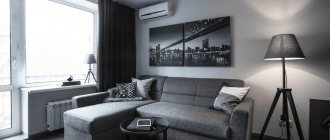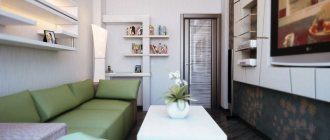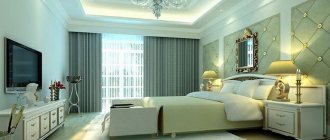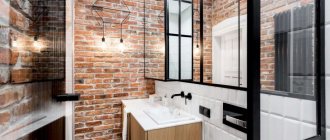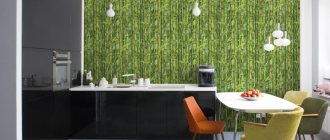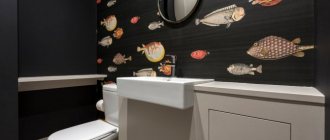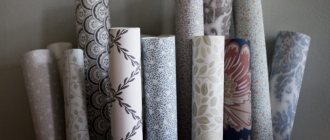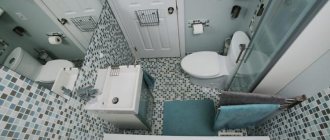Tiling is the most popular, but by no means the only way to decorate walls in the bathroom and toilet. In recent years, another solution has become increasingly relevant and widespread - coloring. This was facilitated, firstly, by the emergence of reliable moisture-resistant water-based paints. Secondly, there was the influence of the West, from where a favorable attitude towards painted surfaces inside residential premises came to us (or rather returned). It's no secret that for many years we perceived paint on walls as something completely unattractive, suitable only for government institutions. Today everything is a little different.
Painted walls in the bathroom and toilet: let's talk about design
Painted walls are relevant for bathrooms designed in a retro style. This is art deco in the spirit of the twenties and thirties, and bright pop art of the middle of the last century, and “cheerful” vintage a la my mother’s youth.
Art Deco is characterized by the use of neutral or restrained color paint with a smoky tint: gray, gray-green, gray-violet, etc.
Retro style from the middle of the last century and later periods, on the contrary, gravitates towards a cheerful palette. However, the colors here are usually not bright, but rather pastel, light in spring.
Painted walls in the bathroom and toilet provide an excellent opportunity to apply drawings and artistic painting. These can be simple ornaments made independently using a stencil, or complex plot compositions created by the artist.
If desired, a bathroom or toilet can be painted not in one, but in several colors, combining them in stripes, zigzag, diamond patterns or panel type.
As you can see, paint on the walls is anything but boring. The proximity to the tiles also adds a significant amount of variety. For the mentioned Art Deco style, the combination of painted surfaces with hog tiles is typical. In a retro bathroom, you can combine paint and patchwork tiles.
In general, the paint is in harmony with any tile - be it vintage or ultra-modern. The options for their interaction are also very diverse.
When it comes to paint color, the rules are simple. The brighter and more spacious the room, the darker the walls can be. And vice versa - for a very small bathroom without a window, light paint is preferable. Of course, you can ignore these postulates and paint your compact bathroom any color you like, even black. This is your right, but you should be aware of the possible consequences - such as darkness, gloominess, coldness, the feeling of walls being drawn closer together.
Acrylate (acrylic or polyacrylic)
Acrylate is one of the types of latex paint. One of the types of synthetic rubbers is used as a base - acrylate, which is why the composition got its name. The properties of acrylic paint for the bathroom can be called optimal:
If you need a bright and deep color, acrylic paint for the bathroom is your choice. Moreover, this color lasts for a very long period of time. An additional bonus is the versatility of the composition: it can be applied to concrete, metal, glass, stone, plastic, brick, plaster.
Acrylic paint for the bathroom is a wonderful solution to the problem
The disadvantages of acrylic paint are also worth knowing:
Overall, acrylic bathroom paint is a good choice. Painted bathroom walls will retain their color for a long time.
Dyeing process
To remove excess paint from a brush or roller, you can use a special tray with grooves. You need to pour a little paint into it and roll the tool along the grooves before painting. If you don't do this, smudges will appear on the walls.
Painting tape should be placed on the borders and all adjacent surfaces, which will prevent you from accidentally painting areas that you do not plan to paint.
First of all, hard-to-reach places and corners should be treated. After this, all the walls are treated, and very carefully. To smooth out unevenness, the first layer should be applied with a brush so that the layer becomes denser.
When it dries well, you can begin applying the second layer with a roller. To create walls that are not monotonous, but with some lines, squares and other shapes, it is better to use special tape. It makes it possible to mark the boundaries of lines very smoothly and without any sagging.
Using this technique, you can make ordinary plain walls very diverse.
To do this, stick masking tape along the intended border and apply a layer of other paint. After the new layer has dried, the tape can be torn off.
Matte and glossy paint: which one to choose?
The glossy surface has a shiny and more attractive appearance, but is only suitable for walls that are perfectly leveled by craftsmen. As for matte surfaces, they are considered universal and hide minor irregularities. Their main disadvantage is insufficient resistance to various mechanical damage. How to remove old paint from a brick wall?
Matte paint goes very harmoniously with any interior.
Modern construction stores sell relief paints that make it possible to obtain a fine structure when processing surfaces, thereby hiding minor irregularities.
Rules for choosing paint
Bathroom paint must have moisture-resistant characteristics and have reliable antibacterial protection, since various microorganisms always multiply well in rooms with high humidity.
For rooms such as bathrooms and toilets, experts advise using the following types of paints:
- Water-based, which can be latex, acrylic, silicone and containing PVA.
- Chlorinated rubber. It is used mainly for finishing swimming pools, as it does not allow water to pass through at all.
- Alkyd enamel. It is considered universal, as it is used for exterior finishing and protection of metal structures from corrosion. Alkyd enamel has moisture-resistant properties, dries quickly and perfectly flows around various irregularities on the surface, without leaving streaks or marks. The composition has a rather unpleasant odor, so it is almost never used in residential areas.
- Oil paint was often used in Soviet times to paint bathrooms. It dries for quite a long time and has an unpleasant aroma. It can be used when there are no other options. One of the disadvantages is that the paint layer quickly begins to crack, and it is very difficult to tear it off the wall.
How to paint instead of tiles?
To apply paint in a toilet, you need paint of a base color or additional shades, equipment, and tools.
Characteristics of good paint:
Tools and materials
When painting, you will need to stock up on the following tools and equipment for repairs:
This is a basic set of tools and materials. Depending on the design and other features of the room, other items may be needed, such as paint for metal surfaces.
Composition selection
Many paints and varnishes can be equally used for finishing a toilet. What colors are popular :
When applied, it emits a very unpleasant, pungent odor, which spreads through the ventilation even to neighbors. It dries completely only after a few days.
Based on the type of surface effect created, textured, glossy and matte paints are distinguished. Flaws and irregularities are least noticeable on textured coatings, and most noticeable on glossy ones. It is necessary to either properly level and prepare the walls, or buy suitable material.
Technical side of the issue
Painted walls will retain their original appearance for a long time if the bathroom is equipped with good ventilation. When planning to paint your bathroom walls, take care of this. Installing forced ventilation is the right step, but not sufficient. It is necessary to leave the bathroom door open as often as possible - at least for an hour after taking water treatments. If the bathroom has a window, great! You need to open it regularly to ventilate the room.
The base surface of the walls should be close to ideal. Remember: paint does not hide defects, but, on the contrary, emphasizes them. To make painted bathroom walls look decent, a high level of preparation is required. This means leveling and repeated priming.
Some paint manufacturers recommend covering walls with fiberglass . The sequence of work in this case is as follows: puttying with a moisture-resistant composition, using a primer with waterproofing properties, gluing fiberglass and again a layer of primer. Of course, after each stage there is a pause until it dries completely. The final step is painting the walls. This finishing is quite expensive, but the result is worth it.
There is one more trick: defects are not visible on a textured surface. This effect can be achieved by using a special textured putty.
With any option, it is worth paying special attention to the preparation of corners - internal and external. Irregularities in these areas will subsequently be very noticeable.
Now about choosing paint. Typically, the container contains information about whether the paint is suitable for bathrooms and kitchens. The coating must contain mold inhibitors, as well as substances that make the surface resistant to moisture and steam. It is desirable that the manufacturer specifically states that the paint can be washed. Sometimes they write like this: “washable paint.”
Gloss paints tend to be more durable, but they are not to everyone's taste. With matte paint, various wall imperfections are much less noticeable. It's up to you to decide, of course.
Those areas of the walls that are constantly exposed to water should be insulated by lining them with ceramics, sheathing them with plastic or covering them with tempered glass. Such a moisture-resistant finish is mandatory for the walls of a shower enclosure in a construction design. Near the bathtub and washbasin, an “apron” or a high border made of tiles, mosaics, or glass will be sufficient.
Preparatory work
The painting process requires careful preparation of surfaces so that the result of the work does not disappoint you. Paint is practically unable to hide unevenness, so the finishing process must be as thorough as possible. Wall preparation is divided into the following working stages:
- Removing old paint and other facing coatings. This can be done using a grinder with a flexible disc for sanding, a spatula, sandpaper, a scraper and various solvents.
- All dust must be removed from the walls by washing it with warm water and covering it with a layer of primer.
- All irregularities should be covered with waterproof acrylic-based putty.
- Sand out any imperfections with sandpaper. If there are formations of fungus and mold, it is necessary to thoroughly treat everything with bleach, a special antiseptic or copper sulfate.
- A flat surface must be coated with several layers of primer. We recommend using latex compounds containing antibacterial components. After each treatment, you should patiently wait for the layer to dry completely.
How to paint a bathroom
You can paint the walls in the bathroom in different ways. Some choose a combined finishing option - the shower stall or part of the wall near the bathtub is tiled, the rest is painted. In this case, the choice of paints is greater, since many can easily tolerate high humidity, but not all can withstand exposure to hot chlorinated water.
Only part of the walls can be painted in the bathroom
If you categorically do not like tiles, even in limited quantities, you can cheat - decorate the painted walls in the splash zone with glass or transparent polycarbonate sheets.
Many people still have concerns about whether it is possible to hang a heated towel rail on a painted wall. The answer is yes, there are no restrictions and there will be no consequences either. Read more about what paints you can use to paint bathroom walls.
